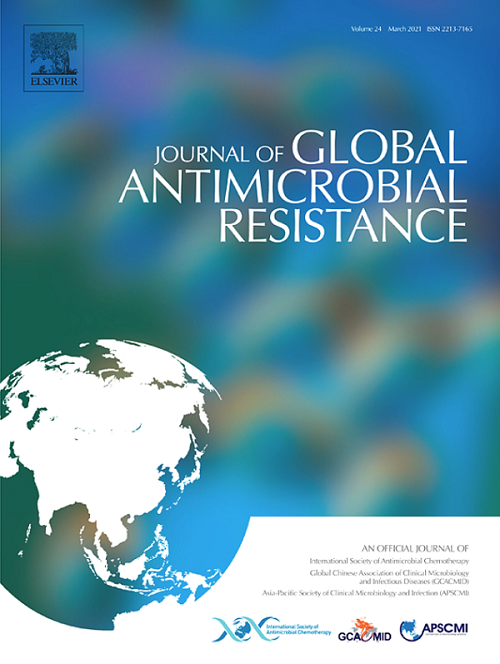iceclc样元件的动员作为铜绿假单胞菌中IMP-13碳青霉烯酶传播的潜在机制
IF 3.7
3区 医学
Q2 INFECTIOUS DISEASES
引用次数: 0
摘要
耐碳青霉烯假单胞菌是一个全球性的公共卫生问题。IMP-13是一种碳青霉烯酶,于2001年首次被描述,但由于碳青霉烯类酶水解能力差,缺乏分子检测,经常被低估。本研究的目的是表征blaIMP-13在铜绿假单胞菌中的遗传支持,并评估移动遗传元件传播这种抗性的能力。2010年至2020年进行的回顾性分析显示,波尔多有8株多重耐药铜绿假单胞菌产生碳青霉烯酶IMP-13。此外,研究中的三个分离株对亚胺培南和亚胺培南-勒巴坦表现出高水平的耐药性,这与oprD基因中的插入序列有关。获得了成功的配对,并对转接合物和亲本临床分离物基因组进行了测序。所有临床分离株均为ST621株。blaIMP-13位于全长88589 bp、GC含量62%的整合共轭元件(ICEclc-like)上,内含85个cds,位于tRNAGly位点PA0729.1。8个临床分离株和数据库中发现的所有ST621株的ICE相同。接合率很低,每个供体大约有10-8个接合子,ICE转移似乎调动了一些位于ICE下游的邻近亲本基因。总之,这些结果表明,即使blaIMP-13的传播主要是由于流行的ST621克隆,携带iceclc样元件的blaIMP-13的动员也是可能的,不应低估。本文章由计算机程序翻译,如有差异,请以英文原文为准。

Mobilization of an ICEclc-Like Element as a Potential Mechanism for the Spread of IMP-13 Carbapenemase in Pseudomonas aeruginosa
Carbapenem-resistant Pseudomonas aeruginosa is a global public health concern. IMP-13 is a carbapenemase that was described for the first time in 2001 but is often underestimated due to poor hydrolysis of carbapenems and a lack of molecular detection. The aim of this study was to characterize the genetic support of blaIMP-13 in P. aeruginosa and to assess the ability of mobile genetic elements to disseminate this resistance. A retrospective analysis conducted between 2010 and 2020 revealed eight multiresistant P. aeruginosa isolates by their production of the carbapenemase IMP-13 in Bordeaux. Additionally, three of the studied isolates exhibited high-level resistance to imipenem and imipenem-relebactam that was linked to an insertion sequence in the oprD gene. Successful mating was achieved, and transconjugants and parental clinical isolate genomes were sequenced. All clinical isolates were found to be ST621 strains. The data revealed that blaIMP-13 was carried on an Integrative and Conjugative Element (ICEclc-like) of 88,589 bp with a 62% GC content harboring 85 CDSs, and was inserted at the tRNAGly locus PA0729.1. The ICE was identical in the eight studied clinical isolates and in all the ST621 strains found in the databases. The conjugation rate was low, at approximately 10–8 transconjugants per donor and ICE transfer appeared to mobilize some adjacent parental genes located immediately downstream of the ICE. In conclusion, these results suggest that even if the spread of blaIMP-13 is mainly due to an epidemic ST621 clone, the mobilization of a blaIMP-13-carrying ICEclc-like element is possible and should not be underestimated.
求助全文
通过发布文献求助,成功后即可免费获取论文全文。
去求助
来源期刊

Journal of global antimicrobial resistance
INFECTIOUS DISEASES-PHARMACOLOGY & PHARMACY
CiteScore
8.70
自引率
2.20%
发文量
285
审稿时长
34 weeks
期刊介绍:
The Journal of Global Antimicrobial Resistance (JGAR) is a quarterly online journal run by an international Editorial Board that focuses on the global spread of antibiotic-resistant microbes.
JGAR is a dedicated journal for all professionals working in research, health care, the environment and animal infection control, aiming to track the resistance threat worldwide and provides a single voice devoted to antimicrobial resistance (AMR).
Featuring peer-reviewed and up to date research articles, reviews, short notes and hot topics JGAR covers the key topics related to antibacterial, antiviral, antifungal and antiparasitic resistance.
 求助内容:
求助内容: 应助结果提醒方式:
应助结果提醒方式:


